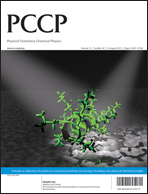Supramolecular H-bonded porous networks at surfaces: exploiting primary and secondary interactions in a bi-component melamine–xanthine system†‡
Abstract
The control over the formation of a bi-component porous network was attained by the self-assembly at a solid–liquid interface by exploiting both primary and secondary non-covalent interactions between

- This article is part of the themed collection: Scanning tunneling microscopy: revealing new physical chemistry insight

 Please wait while we load your content...
Please wait while we load your content...